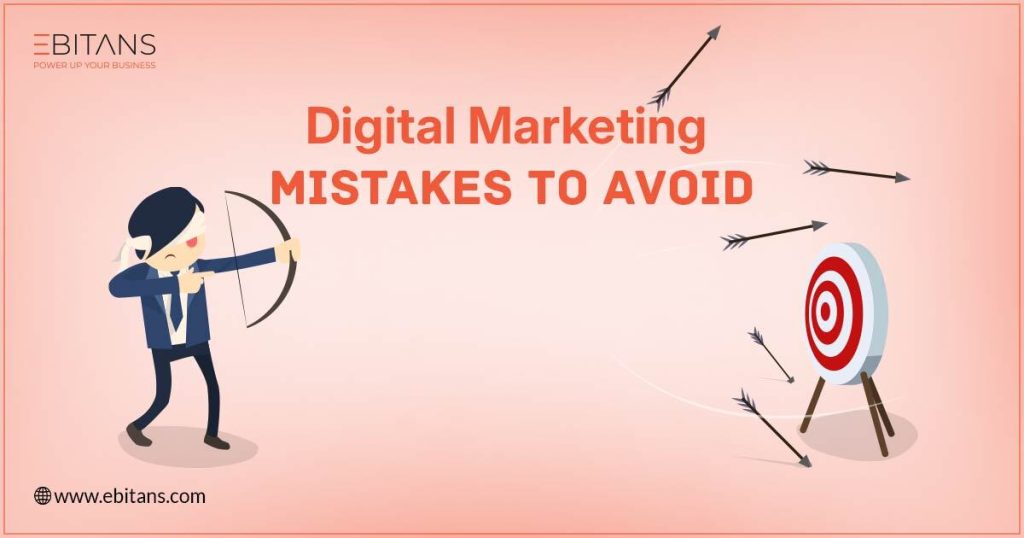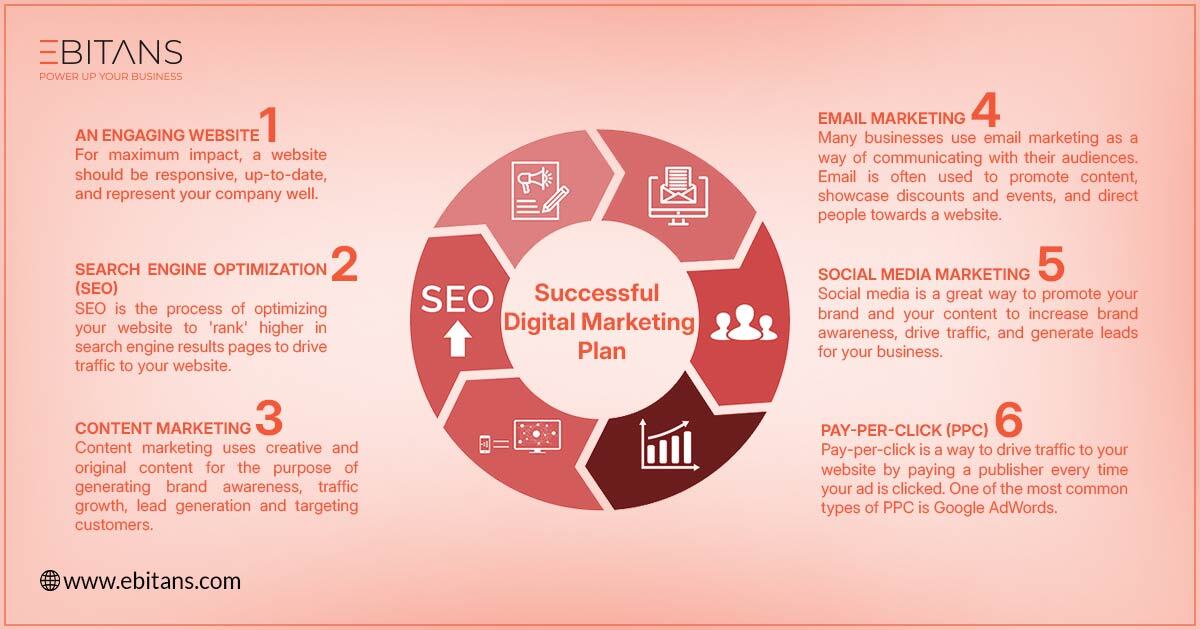Introduction
In today’s competitive business world, having a robust digital marketing plan is no longer optional, it’s essential. A solid plan is your blueprint for online success, whether a small business or a global enterprise. It helps you outline your goals, choose the proper channels, and track your performance. With a plan, your marketing efforts can quickly get noticed in the noise of the digital landscape.
But what is a digital marketing plan? How can you create one that delivers results? In this guide, we’ll walk you through everything you need to know about crafting an effective digital marketing strategy.
What is a Digital Marketing Plan?
A digital marketing plan is a document that outlines your business’s marketing goals and the strategies you’ll use to achieve them through online channels. These channels include websites, social media, email, search engines, and more. The Plan is your roadmap to building an effective online presence that reaches your target audience and achieves your business objectives.
Importance of a Digital Marketing Plan in Today’s Business Environment
The digital world has changed how we interact with brands. Today, most consumers turn to the internet to research products, compare options, and make purchases. A digital marketing plan ensures that your business is visible where your audience spends their time—whether social media, search engines, or email.
With a clear plan, your marketing efforts are likely to be consistent, wasting both time and money. A well-structured digital marketing plan helps you focus your resources on the most effective strategies, ensuring that you reach your goals efficiently.
Why Every Business Needs a Digital Marketing Plan
Creating a digital marketing plan is about more than just going through the motions. It’s about having a clear, strategic direction for your marketing efforts. Here’s why every business, large or small, needs a solid digital marketing plan:
Benefits of Having a Strategic Plan
- Increased Visibility: A structured plan helps you focus on the digital platforms where your audience is most active, increasing your brand’s visibility.
- Cost-Effective: With a well-thought-out plan, you can allocate your budget more efficiently, avoiding wasted spending on ineffective channels.
- Measurable Results: Setting clear objectives and key performance indicators (KPIs) ensures that you can track your progress and adjust your strategy as needed.
How a Digital Marketing Plan Impacts Business Growth
A digital marketing plan isn’t just about getting likes or shares on social media. It’s about aligning your online efforts with your overall business goals. When done correctly, a digital marketing plan drives traffic, increases sales, and ultimately helps your business grow.
For example, if your goal is to increase sales by 20% in the next quarter, your digital marketing plan might focus on lead generation through social media and email campaigns. Every action you take online should be tied to a larger goal that drives business growth.
Aligning Business Goals with Digital Marketing Strategy
One of the biggest mistakes businesses make is creating a digital marketing plan that is unrelated to their broader business goals. Your marketing efforts should support your company’s objectives, whether you’re focused on brand awareness, lead generation, or driving sales. Your digital marketing plan should reflect these priorities.
Critical Elements of a Successful Digital Marketing Plan
Creating a digital marketing plan is more than just throwing together a few tactics. To ensure success, you need to include some key elements.
Defining Objectives and Goals
Before you dive into marketing, you must define success. What are you trying to achieve? Are you aiming to increase website traffic, generate more leads, or boost online sales? Make sure your goals are specific, measurable, achievable, relevant, and time-bound (SMART).
Identifying Target Audience
Knowing your audience is critical. Without a clear understanding of who you’re targeting, your marketing efforts are unlikely to succeed. To tailor your messaging and strategies effectively, create detailed buyer personas that include demographics, interests, and pain points.
Competitor Analysis
Studying your competition helps you identify opportunities and avoid mistakes. What are your competitors doing well? Where are they falling short? Use tools like SEMrush or Ahrefs to gain insights into their strategies and see how you can differentiate yourself.
Digital Marketing Plan Steps: A Comprehensive Guide

Now that we’ve covered the basics let’s dive into the steps of the digital marketing plan that will guide you from start to finish.
Step 1: Conduct a Digital Marketing Audit
Before creating new campaigns, it’s essential to assess your current digital presence. This audit should cover your website, social media profiles, SEO performance, and any other digital marketing efforts.
- Assessing Existing Digital Assets: Review your website, email lists, and social media profiles. What content do you already have? Is it optimized for your target audience?
- Evaluating Current Online Performance: Use analytics tools like Google Analytics to assess your website’s performance in terms of traffic, bounce rates, and conversions. Identify areas for improvement.
Step 2: Define Your Target Audience
Understanding your audience is the cornerstone of any marketing strategy. Without knowing who you’re speaking to, crafting effective messaging is impossible.
- Understanding Buyer Personas: Create detailed personas representing your ideal customers. Include information such as age, gender, occupation, interests, and pain points.
- Segmenting the Market for Targeted Outreach: Divide your audience into segments based on specific criteria. This allows for more targeted marketing that speaks directly to their needs.
Step 3: Set Clear and Measurable Goals
Goals are essential for driving success. Without them, you’re essentially navigating without a map.
- SMART Goals for Digital Marketing: Set goals that are Specific, Measurable, Achievable, Relevant, and Time-bound. For example, “Increase website traffic by 20% within three months” is a SMART goal.
- Aligning Goals with Overall Business Strategy: Ensure your digital marketing goals align with your business objectives. If your company’s focus is customer retention, your digital strategy should support that goal.
Step 4: Choose Digital Marketing Channels
Once you’ve set your goals and defined your audience, it’s time to choose the proper channels for your campaigns.
- Social Media Marketing: Platforms like Facebook, Instagram, LinkedIn, and Twitter allow you to engage with your audience and build brand awareness.
- Search Engine Optimization (SEO): SEO is optimizing your website to rank higher in search engine results, increasing organic traffic.
- Pay-Per-Click Advertising (PPC): With PPC, you bid on keywords to appear at the top of search engine results or on social media platforms. It’s a quick way to drive traffic and generate leads.
- Email Marketing: Email campaigns are an effective way to nurture leads, keep your audience engaged, and drive conversions.
- Content Marketing: Creating high-quality, valuable content—whether through blogs, videos, or social media posts—helps you attract, engage, and convert your target audience.
Step 5: Create a Content Marketing Strategy
Content marketing is a powerful tool for building relationships with your audience and positioning your brand as an industry leader.
- Importance of Content in Digital Marketing: Content is the foundation of almost every digital marketing strategy. High-quality, relevant content helps attract customers, answer their questions, and build trust.
- Crafting Engaging and Relevant Content: Focus on creating content that solves problems for your audience or answers their most pressing questions.
Step 6: Implement Search Engine Optimization (SEO)
SEO is critical for improving your website’s visibility in search results. The better your SEO, the more likely people are to find your business online.
- On-Page SEO: Focus on optimizing content, meta tags, and internal links to improve search engine rankings.
- Off-Page SEO: Build backlinks and enhance your website’s authority through external websites.
- Technical SEO: Ensure that your website is fast, mobile-friendly, and free of technical errors that could hurt your rankings.
Step 7: Set Up Pay-Per-Click (PPC) Campaigns
PPC is an effective way to drive immediate traffic to your website.
- Understanding Google Ads: Google Ads allows you to bid on keywords so your website appears at the top of search engine results. It’s a fast way to generate leads and increase visibility.
- Structuring Effective Ad Campaigns: Make sure your ad copy is compelling and targeted at the right audience. Test different ads to see which ones perform best.
Step 8: Leverage Social Media Marketing
Social media is one of the most effective ways to engage with your audience and build brand awareness.
- Choosing the Right Platforms: Choose social media platforms based on where your audience is most active. For example, a B2B company might focus on LinkedIn, while a B2C brand might prioritize Instagram or Facebook.
- Creating Engaging Social Media Campaigns: Your campaigns should be designed to encourage interaction, whether through likes, shares, or comments. Use visuals, videos, and polls to increase engagement.
Step 9: Monitor and Analyze Performance
Tracking your progress is essential for ensuring your digital marketing plan is on track.
- Utilizing Analytics Tools: Tools like Google Analytics, SEMrush, and HubSpot allow you to monitor your website’s performance and gain insights into what’s working and what’s not.
- Adapting the Plan Based on Data: Don’t be afraid to make changes based on your performance data. If a particular strategy isn’t working, try something new.
Digital Marketing Plan Example
Let’s put these steps into action with a digital marketing plan example to help you see how everything fits together.
A Practical Digital Marketing Plan Example for a Small Business
Imagine you own a small online clothing store. Your digital marketing plan might include:
- Goal: Increase website traffic by 25% in six months.
- Target Audience: Women aged 25-40 who are interested in sustainable fashion.
- Channels: SEO, Instagram, Facebook ads, email marketing.
- Tactics: Create a blog about sustainable fashion, optimize product pages for SEO, run Facebook ads targeting your ideal audience, and send weekly email newsletters with new arrivals and fashion tips.
How Large Enterprises Approach Digital Marketing
For larger companies, a digital marketing plan might include multiple teams, departments, and regions. They may focus on a mix of SEO, influencer marketing, international PPC campaigns, and advanced automation tools.
Common Mistakes to Avoid in Your Digital Marketing Plan

Even the best-laid plans can go awry. Here are some common mistakes to avoid:
Focusing on Too Many Channels
It’s tempting to try every new platform that comes along, but focusing on too many channels can dilute your efforts. Start small and scale up once you’ve mastered a few key platforms.
Neglecting SEO
SEO is a long-term investment that pays off in the form of free, organic traffic. Neglecting it means missing out on valuable opportunities to attract new customers.
Ignoring Data Analytics
If you’re not tracking your performance, you’re flying blind. Use data analytics to refine your strategy and ensure you’re on track to meet your goals.
Marketing Plan for Digital Marketing: Best Practices
Creating a cohesive marketing plan for digital marketing requires a thoughtful, integrated approach.
Creating a Cohesive Marketing Strategy
Your digital marketing plan should complement your overall marketing strategy and align with other channels, such as traditional media, direct mail, and in-person events.
Coordinating with Other Departments
Marketing works in collaboration. Collaborate with other departments, such as sales and customer service, to ensure your digital marketing plan is aligned with the broader business strategy.
The Importance of Budgeting in a Digital Marketing Plan
Budgeting is a critical part of any digital marketing plan. Without a clear budget, it isn’t easy to allocate resources effectively.
How to Allocate Resources Effectively
Decide how much of your budget should go toward organic strategies (SEO, content marketing) and paid strategies (PPC, social media ads). A balanced approach typically works best.
Balancing Organic and Paid Strategies
While paid strategies can deliver quick results, organic strategies are crucial for long-term growth. Aim to strike a balance between the two.
Digital Marketing Plan Sample for Different Industries

Different industries require different approaches to digital marketing. Here’s a look at how various businesses can tailor their plans:
E-Commerce Digital Marketing Plan Sample
An e-commerce business might focus on SEO, PPC ads, and email marketing to drive traffic and increase sales.
SaaS Digital Marketing Plan Example
A Software-as-a-Service (SaaS) company might prioritize content marketing, SEO, and PPC to attract leads and convert them into paying customers.
Local Business Marketing Strategy Example
Local businesses can use geo-targeted ads and local SEO strategies to attract customers in their immediate area.
Tools to Use for Your Digital Marketing Plan
Several tools can help you execute your digital marketing plan more effectively.
Google Analytics
Google Analytics provides deep insights into your website’s performance, helping you track traffic, conversions, and user behaviour.
SEMrush
SEMrush offers a range of tools for SEO, content marketing, and competitor analysis. It’s an essential tool for improving your search engine rankings.
MailChimp
MailChimp is a leading email marketing platform that allows you to create and automate campaigns, track performance, and engage your audience.
Canva
Canva is a design tool that helps you create eye-catching visuals for your website, blog, and social media platforms.
The Future of Digital Marketing Plans
Digital marketing is constantly evolving. Here are some trends to watch for in the future:
Trends to Watch in Digital Marketing
Some of the key trends include voice search optimization, AI-driven marketing, and hyper-personalized experiences.
AI and Automation in Digital Marketing
AI is transforming how businesses approach digital marketing. From chatbots to predictive analytics, AI can help marketers deliver personalized experiences at scale.
How to Update and Adapt Your Digital Marketing Plan
Your digital marketing plan is more than just a static document. It should evolve as your business grows and the digital landscape changes.
Staying Relevant in a Changing Digital Landscape
Keep an eye on changes in consumer behaviour, technology, and market trends. Be prepared to adjust your strategy to stay ahead of the competition.
Adjusting Strategies Based on Performance Metrics
Review your performance data regularly and make changes based on what’s working and what’s not. A successful digital marketing plan evolves.
How to Present Your Digital Marketing Plan to Stakeholders
Once you’ve created your Plan, you’ll need to present it to key stakeholders to get their buy-in.
Structuring a Digital Marketing Plan Presentation
Start with your goals and strategy, followed by the tactics you’ll use to achieve them. Use visuals and data to support your recommendations.
Using Data to Support Your Strategy
Back up your Plan with data from tools like Google Analytics or SEMrush. Show stakeholders how your strategy will drive results and support business objectives.
Conclusion
A well-crafted digital marketing plan is essential for achieving your business’s online marketing goals. By defining clear objectives, choosing the proper channels, and regularly monitoring performance, you can create a plan that drives results and helps your business grow. Start today by setting measurable goals, understanding your audience, and developing a strategy that aligns with your business objectives.
FAQs
What is the most crucial step in creating a digital marketing plan?
The most critical step is defining your target audience and setting SMART goals. These will guide your overall strategy and help ensure that your marketing efforts are aligned with your business objectives.
How often should you update a digital marketing plan?
It’s a good idea to review and update your digital marketing plan every quarter or whenever there are significant changes to your business or the market.
Can small businesses create a digital marketing plan without a big budget?
It’s a good idea to review and update your digital marketing plan every quarter or whenever there are significant changes to your business or the market.
Can small businesses create a digital marketing plan without a big budget?
Yes! Small companies can create an effective digital marketing plan by focusing on organic strategies like SEO and content marketing, which require more time than money.
What are the top tools for executing a digital marketing plan?
Google Analytics, SEMrush, MailChimp, and Canva are some of the top tools to help you manage your digital marketing plan effectively.
How does SEO fit into a digital marketing plan?
SEO is a critical component of any digital marketing plan. It helps you improve your website’s visibility in search results, driving organic traffic and generating leads over time.
